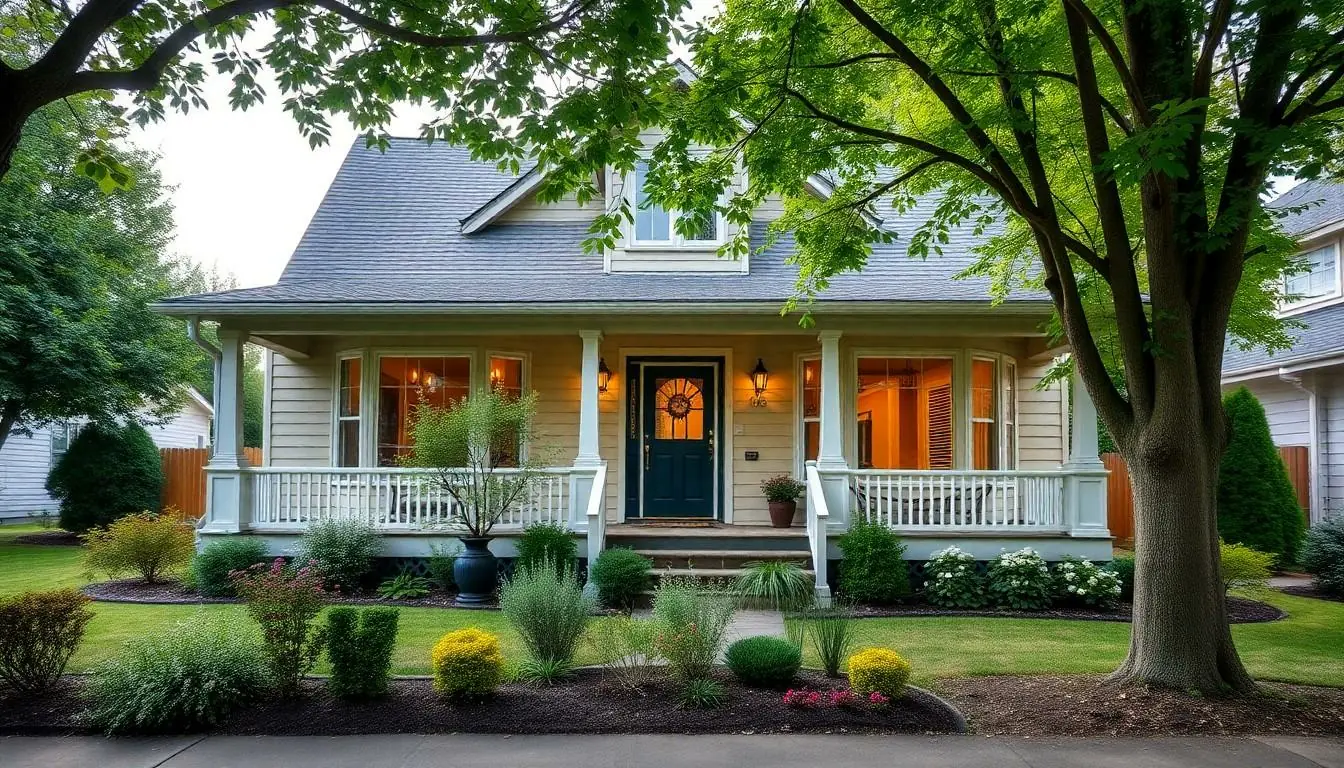Oregon homeowners insurance isn’t just a safety net; it’s your secret weapon against life’s curveballs. Picture this: a rogue tree falls during a storm, or a raccoon decides your attic is its new vacation spot. Without the right coverage, those surprises could leave you scrambling. But with a solid homeowners policy, you can kick back and enjoy Oregon’s stunning landscapes, knowing you’re protected.
Table of Contents
ToggleOverview of Oregon Homeowners Insurance
Oregon homeowners insurance provides essential protection against various risks. This coverage typically includes damage from natural disasters, theft, and liability claims. A standard policy often covers the structure, personal property, and additional living expenses.
Residents frequently choose policies that include specific endorsements to cater to unique needs. For instance, coverage for earthquake damage is particularly relevant in Oregon, where seismic activity is a concern. Flood insurance is also vital due to the risk of heavy rains and snowmelt.
Premiums vary significantly based on several factors. Home location, age, and condition often impact insurance costs. Additionally, the amount of coverage selected plays a crucial role in determining the premium. Homeowners can often lower costs through various discounts, such as bundling policies or maintaining a claims-free history.
Understanding policy exclusions is essential for homeowners. Common exclusions might include damage due to neglect, war, or certain natural events not covered in a standard policy. Reviewing the terms carefully allows homeowners to adjust coverage to meet their specific needs.
Local insurance agents can provide tailored advice. They often help homeowners navigate the complexities of policies to find the best coverage options. Oregon homeowners should evaluate their risk exposure regularly and adapt their insurance to changing circumstances.
Key Coverage Options

Homeowners insurance in Oregon offers several key coverage options. Understanding these options helps residents choose the policy that best fits their needs.
Dwelling Coverage
Dwelling coverage protects the physical structure of the home. This coverage typically includes the house itself, attached structures like garages, and built-in appliances. It covers damages caused by events such as fire, hail, or vandalism. Most policies provide value replacement, ensuring homeowners receive funding to repair or rebuild their homes. Furthermore, policy limits often reflect the home’s replacement cost, so reviewing the policy details is essential.
Personal Property Coverage
Personal property coverage insures residents’ belongings within the home. This includes furniture, electronics, clothing, and personal items. When a covered loss occurs, the policy reimburses homeowners for the damaged or stolen items. Many policies offer actual cash value or replacement cost coverage for property. Homeowners should maintain an inventory of their belongings to facilitate claims processing for lost or damaged items.
Liability Protection
Liability protection provides financial coverage if someone is injured on the property. This essential aspect protects homeowners against legal claims resulting from accidents. It covers medical expenses and legal fees associated with these incidents. A standard policy typically includes liability limits, which can be adjusted for increased protection. Additionally, policyholders might consider umbrella insurance for added liability coverage beyond their primary limit.
Factors Affecting Insurance Rates
Several factors influence homeowners insurance rates in Oregon. Understanding these elements helps homeowners make informed decisions about their coverage.
Location within Oregon
Location significantly impacts insurance rates. Urban areas often experience higher premiums due to increased risks, such as theft and vandalism. Rural locations may offer lower premiums, though natural disaster risks, like wildfires, can raise rates. Proximity to fire stations or emergency services reduces risk, potentially lowering costs. Coastal areas face additional concerns, like flooding and storm damage, increasing rates further. Homeowners should consider these factors when selecting their insurance provider and policy.
Home Characteristics
Home characteristics also play a crucial role in determining insurance rates. Age, construction materials, and overall condition of the home affect risk assessments. Older homes may have outdated systems, leading to higher premiums. Conversely, newer homes often incorporate modern safety features, which can result in lower rates. Roof type and its condition contribute as well; durable materials might lower premiums. Additionally, square footage and property value influence overall insurance costs, with larger homes generally incurring higher premiums. Understanding these details helps homeowners choose the right coverage and limits.
Choosing the Right Insurance Provider
Selecting an appropriate insurance provider plays a vital role in homeowners’ peace of mind. Evaluating options based on individual needs ensures comprehensive coverage.
Comparing Quotes
Reviewing multiple quotes helps identify the best homeowners insurance options in Oregon. Providers may offer varying premiums based on the same coverage. Obtaining at least three quotes allows homeowners to compare costs effectively. Each quote should detail coverage limits and deductibles. Furthermore, assess the financial stability of each insurer through ratings from reputable agencies, such as A.M. Best. Understanding policy features assists homeowners in making informed decisions that suit their unique requirements.
Customer Reviews and Ratings
Evaluating customer reviews provides insight into an insurer’s reputation. Homeowners can find valuable feedback on claims processing and overall satisfaction. Consider checking platforms like Trustpilot or the Better Business Bureau for objective ratings. Reviewing common issues reported by existing customers helps identify potential red flags. An insurer with consistently high ratings likely values customer service and responsiveness. Prioritizing these aspects ensures a smoother experience when handling claims or policy adjustments.
Common Exclusions in Policies
Homeowners insurance in Oregon offers essential coverage, yet exclusions often catch policyholders off guard. Events like flooding and earthquakes typically fall outside standard policy protection. Specific endorsements or separate policies might provide necessary coverage for these risks.
Neglect or lack of maintenance commonly leads to denied claims. Issues such as mold, pest infestations, and roof leaks might not receive compensation if they result from homeowner disregard. Understanding this limitation emphasizes the importance of regular upkeep.
The policy often excludes damage caused by war or acts of terrorism, making these situations uninsurable under typical homeowners insurance. Additionally, expenses related to intentional damage or criminal activity are not covered. Homeowners might face significant financial loss without the awareness of these exclusions.
Sewer backups or sewer-related issues often create confusion regarding coverage. Standard homeowners policies generally do not cover damage stemming from sewer backups unless added specifically. Some homeowners may need to purchase separate sewer backup endorsements for this protection.
Natural events, while frequently covered, may not include certain types of damage. For example, certain wind-related damages may occur due to lack of proper home maintenance. Homeowners must review policies closely to ensure they understand their rights and obligations.
Reviewing these common exclusions helps homeowners in Oregon make informed decisions. Consulting local insurance agents provides clarity on specific coverage options. Agents can help tailor policies to fit individual needs while addressing prevalent exclusions.
Oregon homeowners insurance is an essential investment for protecting one’s home and belongings from unforeseen events. With the right policy in place homeowners can enjoy their surroundings with peace of mind knowing they’re safeguarded against various risks.
By understanding coverage options and potential exclusions homeowners can make informed choices that suit their unique needs. Evaluating multiple quotes and consulting with local agents can help ensure they find the best fit for their situation. Ultimately a comprehensive policy not only provides financial security but also enhances the overall enjoyment of living in beautiful Oregon.







